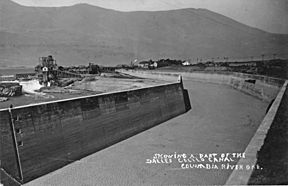Celilo Canal facts for kids
The Celilo Canal was a special waterway built in the early 1900s. It helped boats travel past a dangerous part of the Columbia River between Oregon and Washington, near a town called The Dalles.
Before the canal, an 8-mile (13 km) stretch of the river, especially near Celilo Falls, was very tricky for boats. It was almost impossible to go upstream, and going downstream was risky, even when the water was high. The Celilo Canal was built to create a safe path for steamboats and other river traffic to get around this difficult section.
Quick facts for kids Celilo Canal |
|
|---|---|

Celilo Canal in 1910;
the Columbia River is visible at left. |
|
| Specifications | |
| Maximum boat beam | 65 ft 0 in (19.8 m) |
| Status | inundated by Lake Celilo formed by The Dalles Dam |
| History | |
| Principal engineer | Army Engineers |
| Construction began | 1905 |
| Date of first use | May 15, 1915 |
| Date closed | 1957 |
Contents
Building the Celilo Canal
For many years, people wanted to build a canal around the dangerous parts of the Columbia River. Before the canal, travelers used special roads and railways to get around the falls.
- In 1858, a 19-mile (31 km) wagon road was built.
- In 1863, a 13-mile (21 km) railway replaced the road.
Even with these, a canal was still needed for bigger boats. Building the Celilo Canal finally started in 1905. It took ten years to finish.
Why was the canal important?
In 1909, a magazine called Scientific American wrote about the canal. They explained that the Columbia River was very important for travel in the western United States. The river and its smaller branches stretched for over 2,132 miles (3,431 km).
However, there were two main places where the river was blocked:
- The Cascades: About 60 miles (97 km) from Portland, there were fast-moving rapids. The government had already built a lock canal here about 12 years earlier. This canal was 8 feet (2.4 m) deep and 3,000 feet (910 m) long. It had two locks, which are like water elevators for boats. This allowed steamers to travel from Portland to The Dalles, about 200 miles (320 km).
- The Dalles: This was the second, and even bigger, problem. The river flowed very fast through narrow rock canyons for several miles. The Celilo Canal was built to solve this problem.
What were the hopes for the canal?
Scientific American was very excited about how the canal would help the economy. They believed it would open up a huge area of Washington and Oregon to river boats. This area had:
- Large wheat farms
- Cattle and sheep ranches
- Fruit farms
- Mining districts
Many places in this region did not have railroads. Farmers had to haul their products 50 to 75 miles (80 to 121 km) to the nearest train stations. The new canal would allow boats carrying almost a thousand tons of goods to travel on the upper Columbia River. This was seen as a very important project by the government.
The United States government spent 5 million dollars to build the canal. On May 3, 1915, a steamer named Undine made the first trip through the canal, traveling all the way from Portland to Lewiston.
How the canal changed river travel
After the canal was finished, boats could travel on the Columbia River from its mouth all the way to Priest Rapids. They could also go up the Snake River to the Grande Ronde River.
However, the canal was completed a bit too late. Railroads had already become very popular and had taken away most of the business from steamboats. River travel above Celilo never became as busy as people had hoped. It wasn't until the late 1930s that barges carrying wheat, pulled by diesel towboats, became an important way to transport goods on the Columbia River.
What happened to the canal?
The Celilo Canal and all its structures were flooded in 1957. This happened when The Dalles Dam was finished, creating Lake Celilo. The canal is now underwater.

